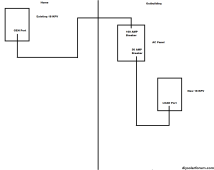I've reach ed out to SS Design Team, but figured I would run this by the knowledgeable folks here.
I have an 18 KPV setup as whole home, using supply side feed, with EG4 batteries. All 4 MPPT are populated, and effecticely maxed (not KW, but layout wise) at 12 KW of panels.
I want to add more solar.
The easiest route (I think) is doing AC Couple on the 18.
I have an outbuilding.
What I would like to do is put an AC Panel in the outbuilding, to power items there.
I would then put panels, a second 18 and batteries at the outbuilding. Connect the load from that 18 to the bottom of the AC Panel (like a backfeed setup), and the main from that panel back to the gen port of the current 18, with that 18 set up to AC Couple.
If I need to run generator, it would connect to the 18 in the outbuilding.
In my head, the outbuilding power needs would be fed by the new 18, solar and batteries. Excess would be pushed to the first 18, and then back to grid from there. I have limits set on the current 18 so that I do not push back too much, I assume (dangerous) that those limits are enforced on the unit regardless of where the excess energy comes from (AC Couple or PV).
Does this design work, or did I miss something?

I have an 18 KPV setup as whole home, using supply side feed, with EG4 batteries. All 4 MPPT are populated, and effecticely maxed (not KW, but layout wise) at 12 KW of panels.
I want to add more solar.
The easiest route (I think) is doing AC Couple on the 18.
I have an outbuilding.
What I would like to do is put an AC Panel in the outbuilding, to power items there.
I would then put panels, a second 18 and batteries at the outbuilding. Connect the load from that 18 to the bottom of the AC Panel (like a backfeed setup), and the main from that panel back to the gen port of the current 18, with that 18 set up to AC Couple.
If I need to run generator, it would connect to the 18 in the outbuilding.
In my head, the outbuilding power needs would be fed by the new 18, solar and batteries. Excess would be pushed to the first 18, and then back to grid from there. I have limits set on the current 18 so that I do not push back too much, I assume (dangerous) that those limits are enforced on the unit regardless of where the excess energy comes from (AC Couple or PV).
Does this design work, or did I miss something?





